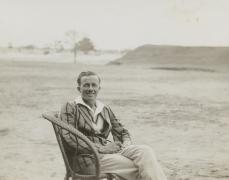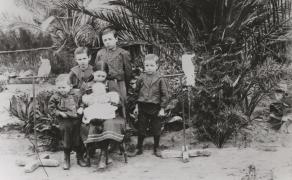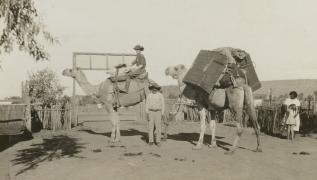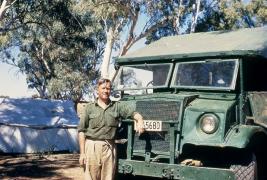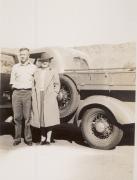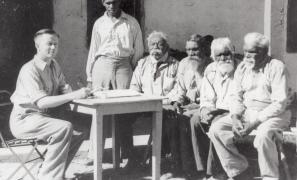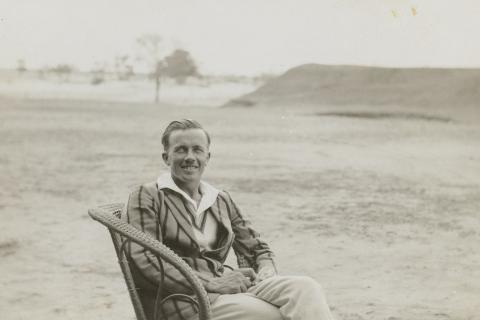Later, more commonly known as Ted, Theodor Georg Heinrich (T.G.H.) Strehlow’s story is fascinating; from his childhood as the young son of the missionary Carl and Frieda, spending his formative years growing up on Hermannsburg Mission, through to his return to Central Australia as the local patrol officer and later anthropologist.
Born in 1908 to Carl and Frieda Strehlow, he spent the first 14 years of his life at Hermannsburg Mission. He recalls that the first 10 years of his life in particular, he had the freedom to run, play and learn with the Arrarnta children. Fluent in Arrarnta, he was drawn back as an adult to record their songs and customs.
T.G.H.’s childhood at Hermannsburg ended when he was 14 years old in October 1922 with the frantic dash, on a horse led buggy driven by Ezekiel (also spelt Hezekiel), with his mother through the harsh bush seeking medical attention for his dying father. That journey ended in tragedy with his father’s death at Horseshoe Bend. T.G.H. was the youngest of 6 children. When the others were sent away to Europe for school, he stayed on the mission growing up with Aboriginal playmates and speaking Arranta. Carl Strehlow had to sit upright day and night for 12 days as the swelling was now so bad that he could not lie down. He endured a 12-day journey during intense heat and over rough terrain.
At the age of 14, in accordance with Lutheran tradition he was confirmed as an adult in the church. What a harsh coming of age for young Theodor, who in the same year had to witness his father’s lingering death. In his book Journey to Horseshoe Bend, written about this final trip with his father, T.G.H. recalls the struggle he had to accept his father’s illness and what he saw as the callous neglect of the mission hierarchy in not providing more assistance to his father. In contrast, he recalls the love of his father and emotion from the Arranta people. For the last time, as the whole community raised their voices in song to farewell Carl Strehlow.
He recalls that suddenly
"Death seemed to have revealed his dark presence; and many of the singers sensed that Death would accompany their ingkata as he left Hermannsburg forever" 1
Margaret the mother of one of TGH’s childhood playmates told him
"You are not just a white boy, you are one of us, you belong to our people. You belong to the totem of the Twins of Ntarea and you are true Aranda"
After his father’s death, Theodor and his mother moved to Adelaide where he completed his higher education. He graduated from Adelaide University (aged 23) Honours in Classics and Literature. He returned to Central Australia in 1932 to research the Arrarnta language and to collect and records the songs and stories.
Strehlow recorded 25 rolls of 16mm film but only three films from this remarkable archive have been edited. None have been released for public viewing. Many of these are of ceremonies which were performed by Arrarnta men who at the time wanted these ceremonies recorded for posterity. In 1936, Strehlow was appointed as the patrol officer (responsible for Aboriginal welfare) for the southern half of the northern territory. He and his first wife Bertha travelled across Central Australia in this position which he held until he joined the army in 1942. Songs of Central Australia written in 1956, but not published until much later in 1971, is an amazing record of some the Arrarnta songs. He translated some these conveying in poetic prose the complexity of Arrarnta understandings of the landscape as a living record of the actions of ancestors, still active agents effecting Arrarnta lives.
In 1933, tribal elders, dreading their dispersal or destruction, asked Strehlow to protect the area’s sacred objects. Agreeing to act as custodian, Strehlow amassed a huge collection of artefacts, photographs and films. This material forms the basis of the collection at the Strehlow Research Centre. While the Strehlow collection is not currently open to the public there is a wealth of information published by T.G.H Strehlow over the years including:
- Strehlow, T. G. H. 1947. Aranda Traditions. Melbourne: Melbourne University Press.
- Strehlow, T. G. H. 1956. Testamenta Ljatinja. Anjkatja Arandauna Knjatiwumala. Adelaide: Council of the British and Foreign Bible Society in Australia.
- Strehlow, T. G. H. 1965. Culture, social structure, and environment. In Aboriginal Man in Australia, (eds) R. M. Berndt and C. H. Berndt, pp. 122–45. Sydney: Angus & Robertson.
- Strehlow, T. G. H. 1969. Journey to Horseshoe Bend. Adelaide: Rigby.
- Strehlow, T. G. H. 1970. Geography and the totemic landscape in Central Australia: A functional study. In Australian Aboriginal Anthropology: Modern studies in the social anthropology of the Australian Aborigines (ed.) R. Berndt, pp. 92–140. Perth: University of Western Australia Press.
- Strehlow, T. G. H. 1971. Songs of Central Australia. Sydney: Angus & Robertson.
- Strehlow, T. G. H. 1978 [1964]. Central Australian Religion: Personal monototemism in a polytotemic community. Special Studies in Religion 2. Adelaide: Australian Association for the Study of Religion.
- Strehlow, T. G. H. 1997 [1950]. Agencies of social control in Central Australian Aboriginal society. Occasional Papers No. 1, October, pp. 1–50. Strehlow Research Centre, Alice Springs, NT.
- Strehlow, T. G. H. 1999. Aranda regular and irregular marriages. Occasional Papers No. 2, December, pp. 1–44. Strehlow Research Centre, Alice Springs, NT.
Theodor Strehlow’s life was not without controversy and he engaged in robust debates with contemporary academics.
He married twice, first to Bertha James, in Prospect, South Australia, on 21 December 1935. They had three children, Theo, Shirley and John. Later he married Kathleen Stuart in 1972, with whom he had a son, Carl. Theodor died in 1978.
- Strehlow, T.G.H., 2015 / 1969 Journey to Horseshoe Bend Giramondo Publishing Co reprint original pub 1969
Media
